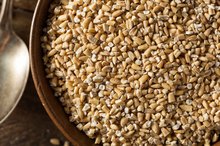Wheat Bran or Oat Bran: Which Is Better?
Whole grains contain a starchy endosperm; a nutrient-rich germ; and an outer fiber layer called bran. A whole grain product will contain all three of these elements, while refined flours have the germ and bran removed. Wheat bran and oat bran are each available as segregated food products that can be used as cereal or incorporated into baked goods and entrees. Wheat bran and oat bran both have a variety of nutritional benefits.
Soluble Fiber
Soluble fiber is a soft type of dietary fiber that absorbs water as it moves through the digestive tract. This softens stool, making it easier to pass and reducing the risk of constipation, hemorrhoids and anal fissures. Soluble fiber helps to lower LDL cholesterol and moderates blood glucose levels. Oat bran is high in soluble fiber, according to Leslie Beck, RD. Beta-lucan, a specific type of soluble fiber found in oat bran, may also boost immune function. Soluble fiber may lower blood pressure and help to reduce inflammation, helping to protect cardiovascular health.
- Soluble fiber is a soft type of dietary fiber that absorbs water as it moves through the digestive tract.
- Beta-lucan, a specific type of soluble fiber found in oat bran, may also boost immune function.
Insoluble Fiber
Steel-Cut Oats: How Much Soluble Fiber Per Day?
Learn More
Wheat bran is high in insoluble fiber. Insoluble fiber bulks up stool and passes through the body in a mostly undigested state. This extra bulk helps move food through the digestive tract more swiftly. Eating insoluble fiber helps you to feel full while consuming fewer calories, and helps your bowel movements to stay regular. High-fiber foods are also usually low in calories relative to their volume. Unlike soluble fiber, insoluble fiber is not associated with lower cholesterol. Wheat bran is beneficial to digestive health, but lacks the cardiovascular, blood glucose and immune system boosts associated with the insoluble fiber found in oat bran.
- Wheat bran is high in insoluble fiber.
- Eating insoluble fiber helps you to feel full while consuming fewer calories, and helps your bowel movements to stay regular.
Uses and Nutrition
Both oat bran and wheat bran can be eaten as hot or cold cereal or sprinkled on yogurt, salads or fruit. Either bran can substitute for breadcrumbs in breading fish or meat. They can add bulk and nutrition to a meat loaf or casserole, and can be used as topping for baked fruit crisps. Bran muffins are a nutritious way to start the day that also aid in ensuring bowel regularity. Wheat bran provides iron, Vitamin C and Vitamin A, while oat bran supplies protein, calcium, and vitamins B-1 and B-2. Both brans have similar texture and only slightly different flavor, but complementary nutritional profiles. Choosing them both, in separate dishes or mixed together, maximizes the nutritional benefits of eating bran.
- Both oat bran and wheat bran can be eaten as hot or cold cereal or sprinkled on yogurt, salads or fruit.
- They can add bulk and nutrition to a meat loaf or casserole, and can be used as topping for baked fruit crisps.
Considerations
Adding Oatmeal to Instant Pancakes
Learn More
Many commercial baked goods that are claimed to contain oat or wheat bran have too little bran to have a substantive positive impact on health, and may be high in fat and salt, according to the American Heart Association. Read labels carefully and opt for whole grains or 100 percent bran eaten as cereal or incorporated into home cooking. Rapidly increasing the amount of fiber in your diet may cause gas and bloating, so increase fiber slowly and drink plenty of water whenever you eat more fiber. Too much fiber may also interfere with the absorption of necessary minerals or with prescription medications, according to the Colorado State University Extension, so consult a physician before making a significant change in your fiber consumption.
- Many commercial baked goods that are claimed to contain oat or wheat bran have too little bran to have a substantive positive impact on health, and may be high in fat and salt, according to the American Heart Association.
- Too much fiber may also interfere with the absorption of necessary minerals or with prescription medications, according to the Colorado State University Extension, so consult a physician before making a significant change in your fiber consumption.
Related Articles
References
- Connecticut State Department of Education; Nutrition Policies and Guidance for the Child and Adult Care Food Program; June 2010
- Oregon State University Linus Pauling Institute; Fiber; Jane Higdon PhD; December 2005
- American Heart Association: Cholesterol, Fiber and Oat Bran
- U.S. Department of Agriculture. Wheat bran, crude. In: FoodData Central. Updated April 1, 2019.
- Francis CY, Whorwell PJ. Bran and irritable bowel syndrome: time for reappraisal. Lancet. 1994;344(8914):39-40. doi:10.1016/s0140-6736(94)91055-3
- Ford AC, Moayyedi P, Lacy BE, et al. American College of Gastroenterology monograph on the management of irritable bowel syndrome and chronic idiopathic constipation. Am J Gastroenterol. 2014;109 Suppl 1:S2-26. doi:10.1038/ajg.2014.18
- Mayer EA, Savidge T, Shulman RJ. Brain-gut microbiome interactions and functional bowel disorders. Gastroenterology. 2014;146(6):1500-12. doi:10.1053/j.gastro.2014.02.037
- Marsh A, Eslick EM, Eslick GD. Does a diet low in FODMAPs reduce symptoms associated with functional gastrointestinal disorders? A comprehensive systematic review and meta-analysis. Eur J Nutr. 2016;55(3):897-906. doi:10.1007/s00394-015-0922-1
- El-Salhy M, Ystad SO, Mazzawi T, Gundersen D. Dietary fiber in irritable bowel syndrome (Review). Int J Mol Med. 2017;40(3):607-13. doi:10.3892/ijmm.2017.3072
- Cockerell KM, Watkins AS, Reeves LB, Goddard L, Lomer MC. Effects of linseeds on the symptoms of irritable bowel syndrome: a pilot randomised controlled trial. J Hum Nutr Diet. 2012;25(5):435-43. doi:10.1111/j.1365-277X.2012.01263.x
- Cozma-Petruţ A, Loghin F, Miere D, Dumitraşcu DL. Diet in irritable bowel syndrome: What to recommend, not what to forbid to patients. World J Gastroenterol. 2017;23(21):3771. doi:10.3748/wjg.v23.i21.3771
- Ford AC, Moayyedi P, Lacy BE, et al. American College of Gastroenterology monograph on the management of irritable bowel syndrome and chronic idiopathic constipation. Am J Gastroenterol. 2014;109(S1):S2-26. doi:10.1038/ajg.2014.187
Writer Bio
A freelance writer since 1978 and attorney since 1981, Cindy Hill has won awards for articles on organic agriculture and wild foods, and has published widely in the areas of law, public policy, local foods and gardening. She holds a B.A. in political science from State University of New York and a Master of Environmental Law and a J.D. from Vermont Law School.








